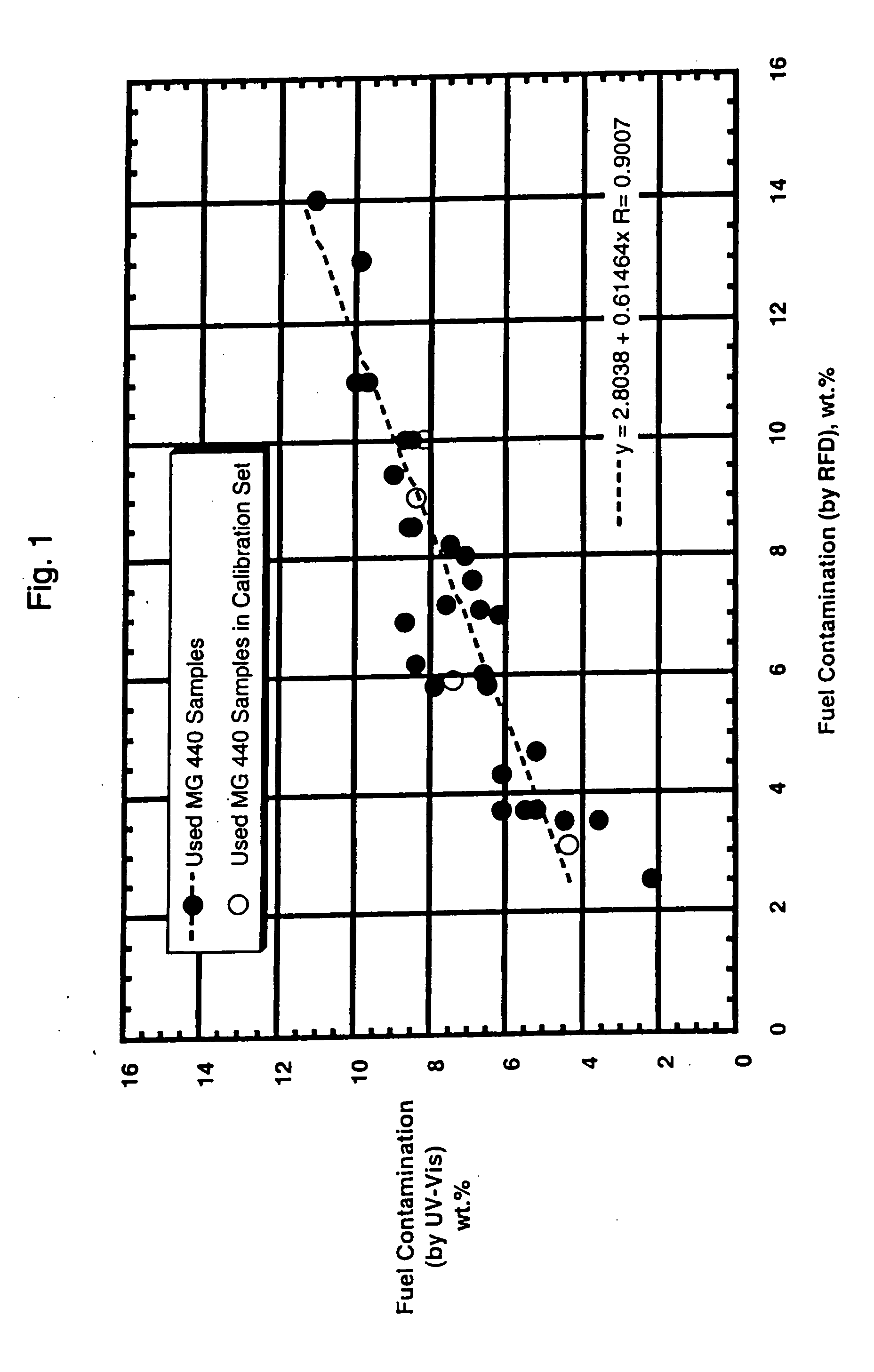Method for determining asphaltenes contamination in used marine engine lubricants using UV-visible spectroscopy and chemometrics
a technology of asphaltenes and lubricants, which is applied in the direction of chemical methods analysis, instruments, testing food, etc., can solve the problems of marine diesel engines, inability to detect and and inability to detect the presence of asphaltenes in the engine,
- Summary
- Abstract
- Description
- Claims
- Application Information
AI Technical Summary
Benefits of technology
Problems solved by technology
Method used
Image
Examples
example 1
Residual Fuel Calibration Samples
[0047] To establish a calibration set of samples, the following types were included: seven sets of new Mobilgard 440 samples contaminated with residual fuel, two sets of a fresh 40 TBN competitive oil (Comp. Oil A) contaminated with residual fuel, three new engine oil samples (Mobilgard 430, Mobilgard 440 and Comp. Oil A) and eight used oil samples.
[0048] The seven sets of fuel-contaminated samples were formed by blending one of seven residual fuels with new Mobilgard 440 at approximately 2.5 wt %, 5.0 wt %, 7.5 wt % and 10 wt % levels. The seven fuels selected were obtained from various regions of the world and have a wide range of asphaltenes content. A listing of the fuel properties is in Table 1, below.
TABLE 1Properties of Fuel Oils Used in Calibration SetSampleKinematic ViscosityDensity @AsphaltenesVanadiumNo.@ 50° C. cSt15° C. cStCCAISulfur wt %wt %(ppm)1173.50.95308232.67.81202N / AN / AN / A1.97.91003756.70.99748524.312.41204423.6N / AN / A2.510.43...
example 2
Testing the UV-Vis Method
[0055] The calibration set described above was evaluated by testing it with 29 additional used Mobilgard 440 samples. Also, the model was tested with two sets of four fuel-diluted new Mobilgard 440 samples made with hydroprocessed base stocks. None of these samples were included in the calibration set.
[0056] The used oil samples were from three vessels for which the fuel vanadium content is well known, so fuel contamination could be determined by RFD analysis with good accuracy. Samples were selected to provide a good range of raw fuel contamination levels. The correlation between the UV-Vis method results and the RFD results is reasonably good, although the best straight line fit does not go through the origin as shown in FIG. 1. The UV-Vis method overestimates fuel contamination at fuel dilution levels 7.25 wt %. Still the correlation is reasonably good with R=0.90. While the UV-Vis method has been found to possess ±20% error, measurement of residual fue...
example 3
Pentane Insolubles
[0059] As with the establishment of the model for use in determining residual fuel contaminants, above, a chemometrics model was developed for pentane insolubles. D893 and UV-Visible estimates are shown in Table 4, below. A correlation plot of the calibration set of samples is shown in FIG. 3.
TABLE 4UV-Visible ResultsPentanePentaneSam-InsolublesInsolublesple(D893b)(UV-Vis)No.wt %wt %Sample Description440.00New MG 440450.00New MG 43080.000.00New MG 440 + Fuel Sample No. 190.000.01New MG 440 + Fuel Sample No. 1100.000.11New MG 440 + Fuel Sample No. 1110.270.25New MG 440 + Fuel Sample No. 1120.000.00New MG 440 + Fuel Sample No. 2130.000.00New MG 440 + Fuel Sample No. 2140.040.09New MG 440 + Fuel Sample No. 2150.150.19New MG 440 + Fuel Sample No. 2160.180.02New MG 440 + Fuel Sample No. 3170.480.29New MG 440 + Fuel Sample No. 3180.710.43New MG 440 + Fuel Sample No. 3190.780.62New MG 440 + Fuel Sample No. 3200.070.01New MG 440 + Fuel Sample No. 4210.240.23New MG 440 +...
PUM
| Property | Measurement | Unit |
|---|---|---|
| weights | aaaaa | aaaaa |
| weights | aaaaa | aaaaa |
| frequency | aaaaa | aaaaa |
Abstract
Description
Claims
Application Information
 Login to View More
Login to View More - R&D
- Intellectual Property
- Life Sciences
- Materials
- Tech Scout
- Unparalleled Data Quality
- Higher Quality Content
- 60% Fewer Hallucinations
Browse by: Latest US Patents, China's latest patents, Technical Efficacy Thesaurus, Application Domain, Technology Topic, Popular Technical Reports.
© 2025 PatSnap. All rights reserved.Legal|Privacy policy|Modern Slavery Act Transparency Statement|Sitemap|About US| Contact US: help@patsnap.com



